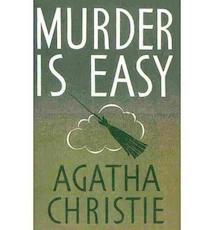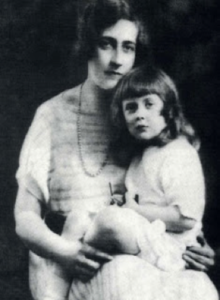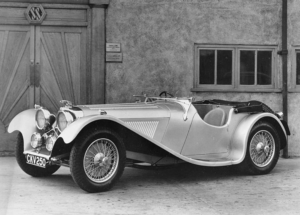
Poirot Score: 58
Murder is Easy
☆☆
Reasons for the Poirot Score
This is a hybrid novel, somewhere between Christie’s adventure thrillers and her whodunnits. The English village setting would have made it a natural Miss Marple novel but in fact there is no proper detective and the solution is discovered in the thriller ending rather than solved. A knowledge of Christie’s techniques of misdirection might lead the reader to the solution, but the objective clues are poor. Read for the twists and turns of the story and put away your thinking cap.
Click here for full review (spoilers ahead)
Trivia
Dedication
“Dedicated to Rosalind and Susan the first two critics of this book”
Rosalind is Christie’s only child born August 5th 1919. She shared her London debutante season with Susan North whose mother, Dorothy, supervised both girls’ itineraries (see One, Two, Buckle my Shoe Trivia). Rosalind and Susan became good friends around the time (1938) that Christie was writing Murder is Easy.
Photo: Rosalind with her mother in the mid-1920s
http://www.findagrave.com/cgi-bin/fg.cgi?page=gr&GRid=73576377
Money to blue
England on leave was one thing. Plenty of money to blue (to begin with anyway!), old friends to look up, meetings with other fellows home like himself …” (Chapter 1)
Luke grinned broadly. A hundred pounds to blue! (Chapter 1)
‘Money to blue’ is no longer commonly used. It is a variant of ‘blow’ as in ‘money to blow’ – to waste, to spend rather lavishly. The first recorded use in the Oxford English Dictionary is from 1846, and by 1938 it seems to have been dying out. I did not come across this usage in speech when growing up in Britain in the 1950s.
The police, lighting up times, and dog licences
John Reed is quite a nice fellow – that’s our constable in Wychwood – a very civil-spoken, pleasant man – but I don’t feel, you know – that he would be quite the person to deal with anything serious. He’s quite used to dealing with people who’ve drunk too much, or with exceeding the speed limit, or lighting-up time – or people who haven’t taken out a dog licence …” (Chapter 1)
The lighting-up time offence is probably about car headlights. The Lights on Vehicles Act of 1907 required the headlights to be switched on for all motor vehicles on unlit roads that were not parked from half an hour after sunset to half an hour before sunrise. It seems likely that there were no street lights in Wychwood. Current regulations in England and Wales also generally require moving bicycles to have lights switched on between sunset and sunrise, a regulation that is widely ignored both by cyclists and the police.
The requirement for dog owners to have a dog licence was abolished in Britain in 1987.
Abercrombie murders
‘What about the Abercrombie case? Wasn’t he supposed to have done away with a goodish few?’ (Luke Fitzwilliam to his friend Jimmy Lorrimer chapter 2 part II)
I imagine this is a reference to Thomas Griffiths Wainewright who is thought to have poisoned his sister-in-law, Helen Abercrombie, in 1830 in order to collect her life insurance. It is also believed that he poisoned his uncle, his mother-in-law and a friend. These murders were never proved but rather as in the case of Al Capone he was successfully prosecuted for forgery and sent to prison in Hobart, Tasmania. [http://en.wikipedia.org/wiki/Thomas_Griffiths_Wainewright]
A Miss Nancy
He doesn’t play golf. Much too much of a Miss Nancy. [Major Horton about Mr Ellsworthy]
There is, for Christie, a connection between golf and Nancy although it is probably irrelevant. Agatha Christie’s first husband, Archie Christie, left her for his golfing partner, Miss Nancy Neele, whom he later married.
The name Nancy is a pet-name for Ann(e). The term Miss Nancy has been used in British English to mean an effeminate man since the early nineteenth century. Anne Bronte, for example, uses the phrase in her novel Tenant of Wildfell Hall where she writes: “You will treat him like a girl – you’ll spoil his spirit, and make a mere Miss Nancy of him”. The term has been rare since the Second World War. More common after the war was nancy-boy or just a nancy. These terms usually meant homosexual.
It seems likely that Mr Ellsworthy is considered to be homosexual, and not simply effeminate, by some of the characters in Murder is Easy. When we first meet him he is described as follows: ‘He had a long pale face with a womanish mouth, long black artistic hair and a mincing walk’. Bridget and Luke seem to take against him to an extraordinary degree after they first meet him: ‘A nasty mind and nasty habits I should say’ Bridget comments. The ‘nasty habits’ appear to be a sly reference to homosexual behaviour. Right at the end of the book Luke says, rather chillingly: ‘I think something unpleasant is going to happen to our Mr Ellsworthy. Battle [a senior policeman] is planning a little surprise’. It sounds as though poor Mr Ellsworthy is going to fall foul of the criminal law. Homosexual behaviour was not decriminalized in England and Wales until the Sexual Offences Act of 1967.
How the Swallow became a Jaguar
The sun was shining when Luke came over the hill and down into the little country town of Wychwood-under-Ashe. He had bought a second-hand Standard Swallow, and he stopped for a moment on the brow of the hill and switched off the engine. [Opening paragraph of chapter 3]
The Standard Swallow can be seen as the first Jaguar car.
The Standard Motor Company, founded in 1903, was a major British manufacturer of mainly saloon family cars until the 1950s. In my childhood in the 1950s Standard cars were almost as common as Austins on British roads. The first Triumph Heralds were made on a Standard chassis.
The Swallow Sidecar Company was founded in 1922. At first it built motorcycle sidecars and then expanded into building the coachwork for cars. The first such car was the 1927 Austin 7 Swallow using the Austin 7 chassis. Shortly afterwards the company was making cars based on the chassis from other car-makers such as Standard and Fiat. William Lyons, co-founder of the Swallow company, was ambitious to break free from a reliance on chassis developed for other cars. He worked with John Black at the Standard Motor Company and commissioned a custom chassis from that company. After producing a one-off sports car Lyons developed a new range of cars starting with the S.S. 1 coupéwhich was first shown at the 1931 motor show.
This range was so successful that Lyons founded a company, SS Cars Ltd in 1934 – the ‘SS’ standing for Standard Swallow. The chassis continued to be made by the Standard Motor Company but with increasing input from SS Carswhich built the bodywork.
The name Jaguar was used in 1936 for the SS Jaguar sports and saloon cars. The 1937 Jaguar SS100 was probably the first car to have the leaping jaguar mascot. After the war, because of the Nazi connotations of SS the company changed its name to Jaguar.
Christie was writing Murder is Easy in 1938. It is not clear how old the second hand Standard Swallow that Luke bought is. With his win of £100 on the Derby he may have bought a 1937 Jaguar SS100, considered one of the most beautiful cars of the period.
http://en.wikipedia.org/wiki/Jaguar_SS100#mediaviewer/File:Jaguar_SS100_-_1937_publicity_photo.jpg



